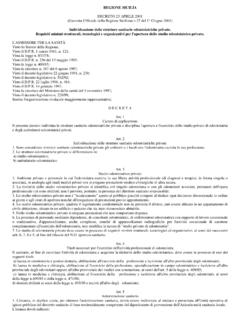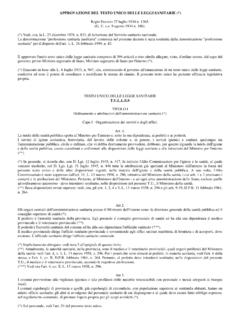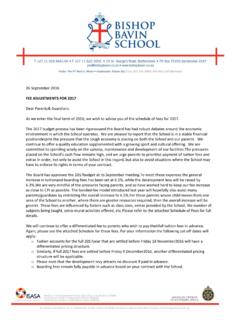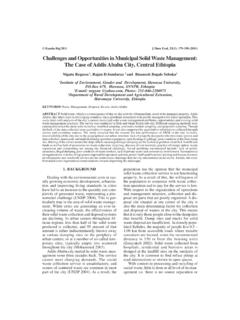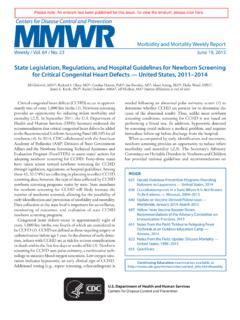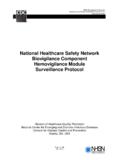Transcription of Study Over 7000 Endosseous Implants Inserted during 25 ...
1 Scient Journal of Dental and Oral Health Open Access Exploring the World of Science ISSN: 2369-4475 Research Article Study Over 7000 Endosseous Implants Inserted during 25 Years in 3300 Interventions. Clinical Results in Different Anatomical and Functional Situations. Statistical Data and Over 20 Years Iconographic Documentation This article was published in the following Scient Open Access Journal: Journal of Dental and Oral Health Received September 27, 2016; Accepted October 05, 2016; Published October 12, 2016. Luca Dal Carlo*. Abstract Calle dei Fabbri 924 (Sestiere San Marco), 30124. Venice, Italy Aim of work: Purpose of this work is to underline advantages of multi-modal implant approach, the goodness of whose choice is confirmed by the analysis of the data gathered during 25 years of implant practice, with gate controls at 5, 8 and 10 years.
2 Suggestions useful to lead clinical practice are derived. Materials and Methods: during 25 years (1989-2014) data concerning 7000. Endosseous Implants have been collected. Different implant shapes have been utilized, letting anatomical morphology lead the choice. An apparatus useful to rigidly join together Implants with a titanium bar has been used to allow immediate load in cases of bony atrophy (intraoral welding machine). A proper database has been compiled. Results: Overall success rates about any implant type here considered have been comprised between 95,5 an 99 % at five years gate control and between 87,7 and 96,6. % at 10 years gate control, widely overcoming the minimum requested by the most used success criteria [1,2]. Suitable implant shape, bicorticalism, immediate solidarization in atrophy cases, respect of healing biologic times, occlusal balance, periodic controls, are key factors for success.
3 Conclusions: Such a Study , allows 1) getting some answers to frequently asked questions about treatment planning; 2) to conceive a schema to choose the correct implant shape in different clinical cases; 3) to help to reduce failure risks. Different shapes of Endosseous implant result useful to treat different anatomical morphologies. Choice about immediate or delayed loading follows anatomical and functional indications. Utilizing implant shapes which properly fit to wide or narrow bony ridges, success rates are similar. Different implant types can support the same fixed bridge. Connecting Implants together by means of a welded bar results particularly useful in atrophy cases. Bicorticalism and respect of principles of static and dynamic occlusion are key factors for success. Passing of time leads to increase implant failures, demonstrating that 1-2 years gate control are not sufficient.
4 Keywords: Multi-modal implant dentistry, Statistical data over 7000 Implants , Intra-oral welding, immediate load Introduction A 25 years Study concerning 7000 Implants of various shapes Inserted during 3300. interventions in 1000 patients can be useful to understand which can be indications for implant planning and success expectations in the various anatomic areas of jaws in relation with prosthetic function. Although some implant protocols are worldwide used to deal with edentulous anterior jaws, these standard treatments can resolve just a part of patient needs, imposing functional and prosthetic compromises. In many cases patient's anatomy leads to choose different implant techniques. In Italy, since the dawn of implant dentistry, besides the most common implant techniques, useful complementary *Corresponding author: Dr.
5 Luca Dal Carlo, Calle dei implant techniques have been developed and checked about their success rate during Fabbri 924 (Sestiere San Marco), 30124 Venice, Italy, the years. This Study represents a data collection of different implant techniques, Tel: +39 0415227465 Fax: +39 0412417637, Email: applied following anatomical and functional needs. Volume 2 Issue 6 048 J Dent Oral Health Citation: Luca Dal Carlo (2016). Study Over 7000 Endosseous Implants Inserted during 25 Years in 3300 Interventions. Clinical Results in Different Anatomical and Functional Situations. Statistical Data and Over 20 Years Iconographic Documentation Page 2 of 10. This statistic Study is characteristic of the private professional yy 10 years success percentage way of working. All the patients have been followed by the same yy Deceased an nowhere-to-be-found patients dentist during every step of the therapy, beginning from the first visit, passing through the operative sessions (surgical and Deceased patients and nowhere-to-be-found patients have nonsurgical), carrying on with periodic controls.
6 Been excluded from this statistic. If patient is rich of bone, Implants of any shape get good Many implant systems have been used, whose selection has success expectations, which can be completely different when been depending on: bone is scarce. Some Implants shapes, which don't fit to ideal 1. Anatomic characteristics gathered observing diagnostic anatomic conditions, seem to be the best choice when bone width tests and the objective examination done at the beginning or depth is scarce. of surgical intervention;. Numerous studies show negative influence of occlusal 2. Prosthetic function;. unbalance on implant's prognosis, even after complete osseointegration [3-8]. Therefore, though some Authors [9-11] 3. Standard or urgency situation;. published studies whose conclusions are that it's possible to establish success prognosis of Implants with a short follow up (1 4.)
7 Immediate or delayed load. or 2 years), I preferred to check Implants at gate controls after 5, All interventions have been done under local anesthesia, 8 and 10 years, getting the results here described, which confirm giving to the patients, if there weren't contraindications: that implant failures increase following passing of time and that periodic controls are mandatory to prevent their occurrence and 1. some anti-anxiety drops (benzodiazepines) to: their consequences. a. prevent troubles tied to anxiety, Materials and Methods b. counterbalance stress influence over tissues acidity, during 25 years (1989-2014) the data concerning implant 2. an anti haemorragic pill (tranexamic acid) to reduce interventions executed have been collected. A proper database bleeding during intervention. has been compiled by registering: With rare exceptions, interventions in healed ridges have yy Surgical intervention progressive number been done beginning by opening flaps, to carefully examine the bony ridge, to correctly manage the soft tissues and to activate all yy Patient's progressive number the biologic post-surgical inflammation processes which lead to yy Date of intervention new bone regeneration and optimum soft tissues healing.
8 Yy Patient's gender Post-extractive Implants have all been Inserted in fresh extraction sites. yy Other interventions progressive numbers Except for about 20 overdentures, treated with the O-Rings yy Patient's age technique, the definitive prosthesis has all been cemented. yy Age's range (11-20, 21-30, 31-40, etc.) during the years some implant systems have been abandoned, yy Patient's current and past pathologies to get better performing shapes or simply because they are no more on sale, even if apart of them had good characteristics and yy Intervention's description success rates. Five, eight and ten years after intervention's date the patients Many implant shapes have been utilized (Figure 1): have been contacted, and when necessary visited, to check Implants success. Data collected in the database have then been Submerged screw Implants (2164 Implants ).
9 Inserted in a Microsoft Excel file, including: Ten implant systems have been utilized (most utilized: n. 5-9. yy Up-to-date date in Figure 1). These Implants have been employed both in long time healed bony ridges and as immediately post-extractive Implants , yy Implant's type normally with delayed load, but also with immediate load. yy Number of Implants overcoming 5 years duration Non-submerged screw Implants (212 Implants ). yy Number of Implants failed before 5 years Three implant systems have been utilized (most utilized: n. yy 5 years success percentage 10-11 in Figure 1). These Implants have been employed both in long time healed bony ridges and as immediately post-extractive yy Number of Implants overcoming 8 years duration Implants , just with delayed load. yy Number of Implants failed before 8 years One-piece screw Implants (2495 Implants ).
10 Yy 8 years success percentage Eight implant systems have been utilized (most utilized: n. yy Number of Implants overcoming 10 years duration 12-19 in Figure 1). These Implants have been employed both in long time healed bony ridges and as immediately post-extractive yy Number of Implants failed before 10 years Implants , with immediate load, rarely with delayed load. Volume 2 Issue 6 048 J Dent Oral Health Citation: Luca Dal Carlo (2016). Study Over 7000 Endosseous Implants Inserted during 25 Years in 3300 Interventions. Clinical Results in Different Anatomical and Functional Situations. Statistical Data and Over 20 Years Iconographic Documentation Page 3 of 10. Figure 1: Various shapes of Endosseous Implants utilized (red: one-piece Implants ; brown: submerged Implants ; violet: non-submerged Implants ). Blade Implants (693 Implants ) Implant shape Healed Post Delayed Immediate ridges Extractive load load Three implant systems have been utilized (most utilized Subm.)

